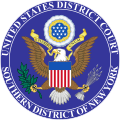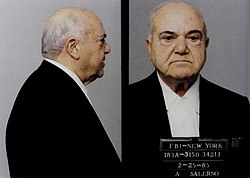Developments
On February 25, 1985, nine New York Mafia leaders were indicted for narcotics trafficking, loansharking, gambling, labor racketeering and extortion against construction companies. [11] On July 1, 1985, the original nine men, with the addition of two more New York Mafia leaders, pleaded not guilty to a second set of racketeering charges as part of the trial. Prosecutors aimed to strike at all the crime families at once using their involvement in the Commission. [12] On December 2, 1985, Dellacroce died of cancer. [14] Castellano was later murdered on December 16, 1985. [15]
According to Colombo hitman and FBI informant Gregory Scarpa, Persico and Gambino boss John Gotti backed a plan to kill the lead prosecutor, and future New York mayor, Rudy Giuliani in late 1986, but it was rejected by the rest of the Commission. [16]
In the early 1980s, the Bonanno family were kicked off the Commission due to the Donnie Brasco infiltration, and although Rastelli was one of the men initially indicted, this removal from the Commission actually allowed Rastelli to be removed from the Commission Trial as he was later indicted on separate labor racketeering charges. Having previously lost their seat on the Commission, the Bonannos suffered less exposure than the other families in this case. [17] [18]
When the lawyers for the accused mafiosi reviewed the evidence, they realized their clients' chances at trial were slim. However, when they sounded out possible plea bargain terms, Giuliani demanded that the defendants plead guilty to the stiffest charges in the indictment, which carried sentences that would have all but assured they would die in prison. [19] The seven defense lawyers, as well as Persico's legal adviser (Persico was acting as his own lawyer) then decided to admit that the Mafia and the Commission existed, but argue that membership in the Mafia or being a boss were not in and of themselves evidence of criminal activity. The mafiosi initially balked, believing that it would amount to a violation of the code of omertà. However, the lawyers impressed upon their clients that they could not credibly deny the existence of the Mafia in the face of their own recorded references to it. Ultimately, the mafiosi agreed to this strategy as long as they did not have to personally admit the Mafia existed. [20]
Hence, during his opening statement, Santoro's lawyer, Samuel Dawson, told the jury that there was no question that "the Mafia exists and has members," but asked, "Can you accept that just because a person is a member of the Mafia that doesn't mean he committed the crimes charged in this case?" It was the first admission in open court that the Mafia existed. [21] [22]
Verdicts
After six days of deliberations, the jury convicted eight defendants of racketeering on November 19, 1986, [5] with the exception of Indelicato who was convicted of murder (of Carmine Galante), [13] and were sentenced by judge Richard Owen on January 13, 1987, as follows: [23] [24]
| Defendant | Position | Penalty | Status | Date of death |
|---|
| Anthony "Fat Tony" Salerno | Boss, Genovese family | 100 years' imprisonment and fined $240,000 | Deceased | July 27, 1992, MCFP Springfield [25] |
| Antonio "Tony Ducks" Corallo | Boss, Lucchese family | 100 years' imprisonment and fined $240,000 | Deceased | August 23, 2000, MCFP Springfield [26] |
| Salvatore "Tom Mix" Santoro | Underboss, Lucchese family | 100 years' imprisonment and fined $250,000 | Deceased | January 2000, in federal custody |
| Christopher "Christie Tick" Furnari | Consigliere, Lucchese family | 100 years' imprisonment and fined $240,000 | Deceased; had been released on September 19, 2014 | May 28, 2018 [27] |
| Carmine "Junior" Persico | Boss, Colombo family | 100 years' imprisonment and fined $240,000 | Deceased | March 7, 2019, Duke University Medical Center [28] |
| Gennaro "Gerry Lang" Langella | Acting boss/underboss, Colombo family | 100 years' imprisonment and fined $240,000 | Deceased | December 15, 2013, MCFP Springfield [29] |
| Ralph "Ralphie" Scopo | Soldier, Colombo family | 100 years' imprisonment and fined $240,000 | Deceased | March 9, 1993, in federal custody [30] |
| Anthony "Bruno" Indelicato | Capo, Bonanno family | 40 years' imprisonment and fined $50,000 | Released in 1998 [31] | N/A |
Salerno had initially been billed as the boss of the Genovese family. However, shortly after the trial, Salerno's longtime right-hand man, Vincent "The Fish" Cafaro, turned informant, told the FBI that Salerno had been a front for the real boss, Vincent "The Chin" Gigante. Cafaro also revealed that the Genovese family had been keeping up this ruse since 1969. [32] [33] However, according to New York Times organized crime reporter Selwyn Raab, this would not have jeopardized Salerno's conviction at the Commission Trial or his 100-year sentence. In his book, Five Families, Raab noted that Salerno had been tried and convicted for specific criminal acts, not for being the Genovese boss. [34]




